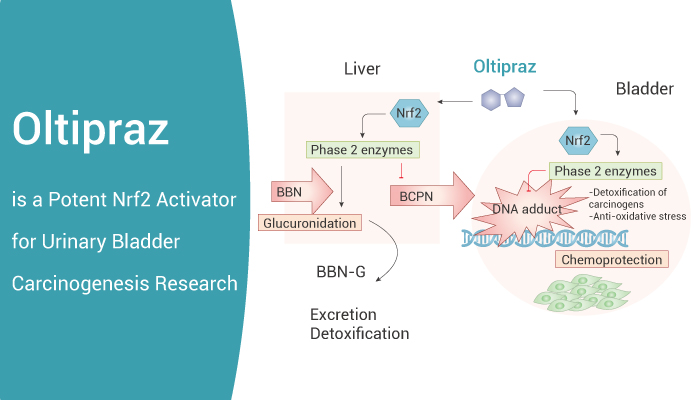Studies suggest chemically induced cancer formation. According to report, oral administration of BBN (N-butyl-N-(4-hydroxybutyl)nitrosamine) to rats and mice induces cancer specifically in the urinary bladder. Carcinogens are normally detoxified by conjugation with water-soluble cofactors. These conjugating enzymes have been categorized as phase 2 detoxifying enzymes. Oltipraz (4-methyl-5-[2-pyrazinyl]-1,2-dithiole-3-thione) represents one of the most potent inducers of phase 2 enzymes. Transcription factor Nrf2 is an essential regulator of the inducible expression of detoxifying enzyme genes by chemopreventive agents. Today, we will introduce the susceptibility of Nrf2−/− mice to the urinary bladder-specific carcinogen BBN and the preventive efficacy of oltipraz in these mice.

Oltipraz is a Potent Nrf2 Activator for Urinary Bladder Carcinogenesis Research
Firstly, the incidence of urinary bladder carcinoma by BBN was significantly higher in Nrf2−/− mice than in wild-type mice. And, it exhibits invasive carcinoma in 24.0 and 38.5% of wild-type and Nrf2−/− mice, respectively. Secondly, Oltipraz induced the phase 2 enzymes responsible for BBN detoxification in the liver and urinary bladder in an Nrf2-dependent manner. Therefore, oltipraz decreased the incidence of urinary bladder carcinoma by BBN in wild-type mice but had little effect in Nrf2−/− mice. Meanwhile, in wild-type mouse liver, oltipraz significantly induced BBN glucuronidation and decreased the urinary concentration of N-nitrosobutyl(3-carboxypropyl)amine. Importantly, BBN was found to suppress the expression of UGT1A specifically in the urinary bladder. This suppression was counteracted by oltipraz in wild-type mice but not in Nrf2−/− mice.
These results show that Nrf2 and its downstream target genes are responsible for BBN detoxification. Furthermore, oltipraz prevents carcinogenesis by BBN by enhancing detoxification of this carcinogen in the liver and urinary bladder.
Collectively, the cellular defense enzymes under the regulation of Nrf2 play key roles in preventing urinary bladder carcinogenesis.
References:
[1] Iida K, et al. Cancer Res. 2004 Sep 15;64(18):6424-31.